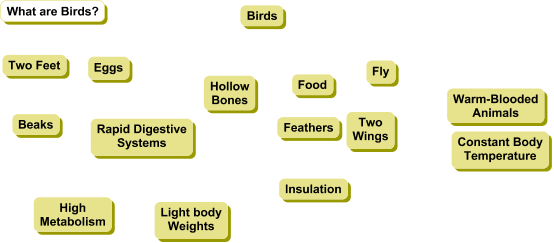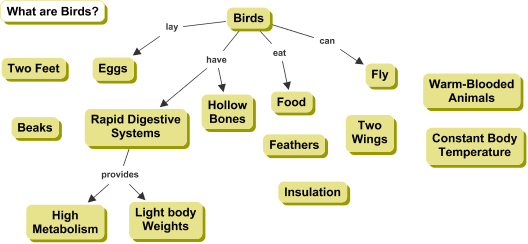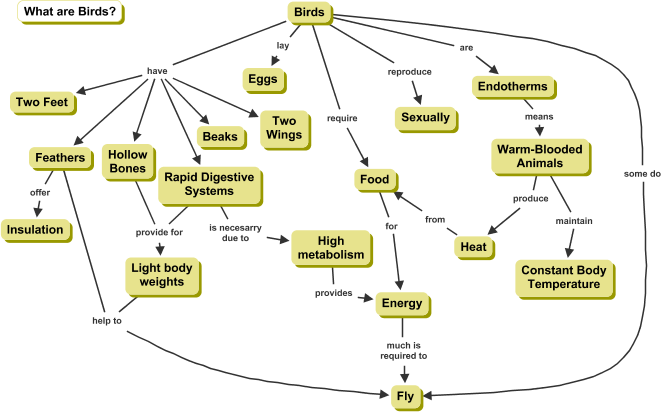There is no simple recipe or set of steps for constructing a concept map. When writing, whether a novel, a poem, or a research paper, every author has their own style. Similarly, experienced concept mappers use different strategies when building their Cmaps. Some start by listing a set of concepts, others go directly to placing a root concept and start linking other concepts from it. In this document we present a few steps that users can take when constructing their first concept map that we have found useful throughout the years while helping many people to build concept maps.
In learning to construct a concept map, it is important to begin with a domain of knowledge that is very familiar to the person constructing the map. Since concept map structures are dependent on the context in which they will be used, it is best to identify a segment of a text, a laboratory or field activity, or a particular problem or question that one is trying to understand. This creates a context that will help to determine the hierarchical structure of the concept map. It is also helpful to select a limited domain of knowledge for the first concept maps.
A good way to define the context for a concept map is to construct a Focus Question, that is, a question that clearly specifies the problem or issue the concept map should help to resolve. Every concept map responds to a focus question, and a good focus question can lead to a much richer concept map. When learning to construct concept maps, learners tend to deviate from the focus question and build a concept map that may be related to the domain, but which does not answer the question. It is often stated that the first step to learning about something is to ask the right questions.
Given a selected domain and a defined question or problem in this domain, the next step is to identify the key concepts that apply to this domain (see the companion document, What is a Concept? ... from a Concept Mapping Perspective, for an explanation about concepts). Usually 15 to 25 concepts will suffice. We recommend using the smallest number of words, usually a single word, for each concept to be entered. Figure 1 is an example of an initial set of concepts for a concept map about Birds. The easiest way to build this list and to construct a concept map from it is by using a software program such as IHMC CmapTools (Cañas et al., 2004, http://cmap.ihmc.us). We refer to this list of concepts as a parking lot, since we will move these concepts into the concept map as we determine where they fit in. Some concepts may remain in the parking lot as the map is completed if the mapmaker sees no good connection for these with other concepts in the map. Important additional concepts might be identified as the map is being built.

Figure 1. The Focus Question and parking lot: an initial set of concepts for a concept map about Birds.
Concept maps tend to be hierarchical in nature, with more general concepts at top and more specific concepts to the bottom. However, the hierarchical nature does not necessarily imply a physically hierarchical structure, as concept maps can just as well be cyclical (Safayeni et al., 2005) or have more than one root concept. However, our experience teaching concept mapping has shown us that it is much easier to begin by building hierarchical concept maps, with a single root concept.
The listed concepts in the parking lot can now be ranked into an ordered list from the most general, most inclusive concept, for this particular problem or question at the top, to the most specific, least general concept at the bottom of the list. This rank order is a first approximation of organizing the concepts, but it helps us to begin the process of map construction. This ranking can be in the form of a list, or an approximate location for some of the concepts on the map can be used, as shown in Figure 2. Concepts can be easily moved around with CmapTools, so this placement is just a way to get started.

Figure 2. Concepts are now placed in an approximate ranking of most general to most specific from top to bottom, and may be moved around the canvas to start forming the map.
The next step is to construct a preliminary concept map. This involves starting to connect concepts, using linking words, to create propositions (see the companion document, What are Linking Words? ... from a Concept Mapping Perspective, for an explanation of linking words, and What are Propositions? ... from a Concept Mapping Perspective, for an explanation of propositions). For every two concepts that are linked, great care must taken to assign linking words that clearly define the resulting proposition. In concept mapping there is no predetermined list of linking words. We consider that this would limit the expressability of the user. However, linking words usually consist of, or include, a verb, and we recommend that they be as specific as possible in expressing the relationship between the two concepts. As the concept map is created, concepts are moved around, added, removed, and redefined. It is common to try several possible linking words when linking two concepts, in an attempt to construct the clearest, most easily understood proposition in each case. Figure 3 shows the first few linking words added to the concepts from Figure 2.

Figure 3. Linking words are added to join concepts forming propositions.
The process of constructing the concept map continues by linking the rest of the concepts, revisiting the linking words, adding other concepts, etc. Care must be given to making sure that every two concepts with their corresponding linking phrases form a proposition that makes sense, that it is a unit of meaning, and that long sentences are not included in the concept map spanning through several concepts and linking phrases.
After a preliminary map is constructed, it is always necessary to revise this map. Good maps usually result from three to many revisions. This is one reason why using computer software is helpful. Once the preliminary map is built , cross-links should be sought. These are links between concepts in different segments or domains of knowledge on the map that help to illustrate how these domains are related to one another. Cross-links are important in order to show that the learner understands the relationships between the sub-domains in the map. For example, "High Metabolism provides Energy" is a cros-link that joins the subdomian that contains the concept "Rapid Digestive Systems" with that of the cocnept "Food". "Warm-Blooded Animals produce heat from Food" is also a cross-link.
It is important to recognize that all concepts are in some way related to one another. Therefore, it is necessary to be selective in identifying cross-links, and to be as precise as possible in selecting the linking words that connect concepts. In addition, one should avoid “sentences in the boxes”, that is, full sentences used as concepts, since this usually indicates that a whole subsection of the map could be constructed from the statement in the box.
A concept map is seldom "finished". There are always more concepts that could be added and refinements that could be made. Figure 4 shows a completed (never finished) version of the concept map. Notice that, compared to Figure 3, some more concepts have been added, others have been moved around, linking phrases have been rethought, and crosslinks have been added.

Figure 4. Completed (but not final) concept map about Birds.
Students often comment that it is hard to add linking words onto the “lines” of their concept map. This is because they poorly understand the relationship between the concepts, or the meanings of the concepts, and it is the linking words that specify this relationship. Once students begin to focus-in on good linking words, and on the identification of good cross-links, they can see that every concept could be related to every other concept. This also produces some frustration, and they must choose to identify the most prominent and most useful cross-links. This process involves what Bloom (1956) identified as high levels of cognitive performance, namely evaluation and synthesis of knowledge. Concept mapping is an easy way to encourage very high levels of cognitive performance, when the process is done well. This is one reason concept mapping can also be a very powerful evaluation tool (Edmondson, 2000).
Finally, the map should be revised, concepts re-positioned in ways that lend to clarity and better over-all structure, and a “final” map prepared. When computer software is used, one can go back, change the size and font style, and add colors to “dress up” the concept map.
Thus, we see that concept maps are not only a powerful tool for capturing, representing, and archiving knowledge of individuals, but also a powerful tool to encourage meaningful learning and to create new knowledge.
Bloom, B.S. (1956). Taxonomy of Educational Objectives: Cognitive Domain. New York: David McKay Company, Inc.
Edmondson, K. (2000). Assessing Science Understanding through Concept Maps. In J Mintzes, J. Wandersee & J. Novak (Eds.), Assessing Science Understanding (pp. 19-40). San Diego: Academic Press.
Safayeni, F., Derbentseva, N., & Cañas, A. J. (2005). A Theoretical Note on Concept Maps and the Need for Cyclic Concept Maps. Journal of Research in Science Teaching, 42(7), 741-766.
Last update: August. 28, 2009